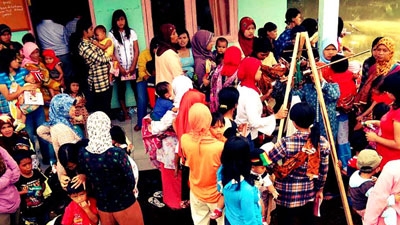PNPM Generasi is an innovative program using incentivized block grants to target three Millennium Development Goals lagging in Indonesia: maternal and child health and universal primary education. PNPM Generasi builds on the National Community Empowerment Program in Rural Areas (PNPM-Rural) and is currently active in eight provinces, 290 sub-districts, and 2,892 villages. For further information on the program, please see the results profile.
PNPM Generasi has had three waves of evaluation, including a Baseline Survey (2007) and Mid-Term Impact Evaluation (2009), and Final Impact Evaluation (2011). The main findings of the PNPM Generasi Final Impact Evaluation are as follows:
- PNPM Generasi positively impacted all targeted health and education indicators.
- Health indicators showed the largest gains, including
- Increased frequency of weight checks for young children;
- Increase in the number of iron sachets pregnant mothers received through antenatal care visits; and
- Dramatic increases in health post (posyandu) participation by mothers and children to receive targeted maternal, neonatal, and child health services.
- All education indicators improved, reversing the zero or negative impact found at the mid-term evaluation. The biggest improvement came in school participation rates among primary school students.
- PNPM Generasi’s main long-term impact was a decrease in childhood malnutrition levels (10% against control). Overall reductions were strongest in areas with higher malnutrition rates prior to project implementation, most notably in Nusa Tenggara Timur.
- PNPM Generasi showed strong positive impact on indicators in NTT.
- Decreased underweight and severe underweight rates, by 20% and 33% against control, respectively.Stunting was decreased by 21% against control.
- Increased junior secondary school gross enrollment rate by 29% against to control.
- Raised gross primary schools attendance rates for 7-12 year olds by 4% against control.
- PNPM Generasi had the greatest impact in areas with low baseline health and education indicators. On average, the project was about twice as effective in areas with very low health and education status (10th percentile of service provision). Greater impacts observed in health and education indicators were not correlated with pre-project levels of poverty, but with low baseline indicators.
Policy Implications
- Expansion of PNPM Generasi would be most effective in areas where project indicators are lagging, not necessarily in areas identified as poor.
- Community incentives had mixed results—health responded more favorably than education. This may point to incentivized community interventions being effective in other lagging areas, such as water and sanitation access. Poverty programs may wish to experiment more with embedding incentives into the designs, along with consistent monitoring and evaluation.
- The architecture and network of PNPM-Rural proved to be a flexible and adaptable platform through which to increase utilization of basic health and education services. PNPM Generasi has shown that the existing national community-driven development architecture and machinery can be adapted to target specific outcomes. PNPM Generasi is a potential vehicle for improving health and education indicators in supply-deficient areas where the traditional household conditional cash transfer model may not be as effective due to supply constraints.
- The project should regularly review the appropriateness of the targets. With school participation for children ages 7–12 near universal, other lagging targets could be added, such as education learning achievement, early childhood development, or water and sanitation.
- Further evaluation to examine the longer-term sustainability of interventions and impacts could be undertaken, should the project continue in the original treatment and control sites. Complementary studies can explore how increased interaction between communities and service providers influence outcomes.


